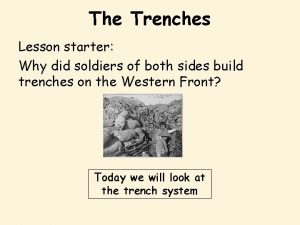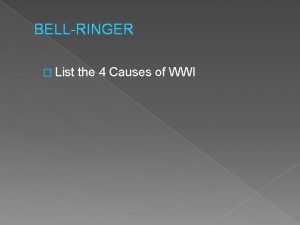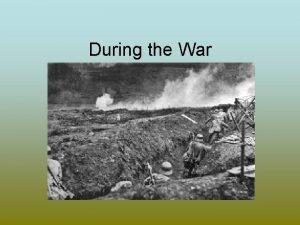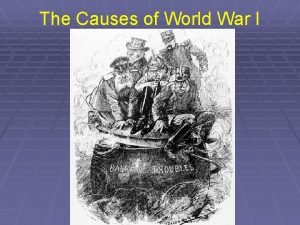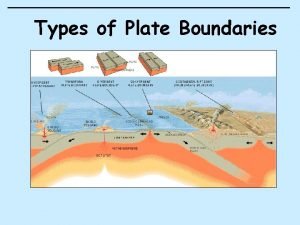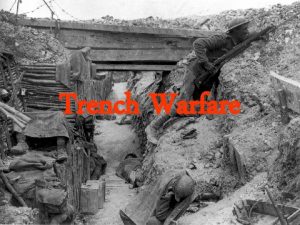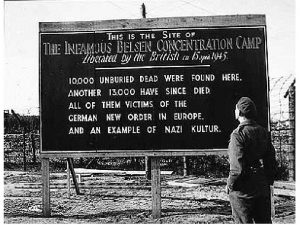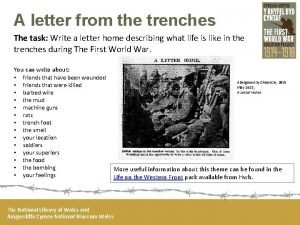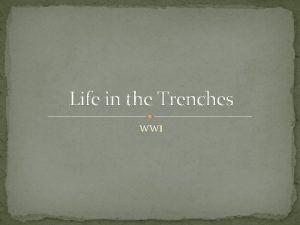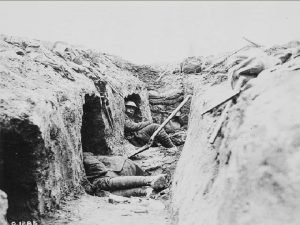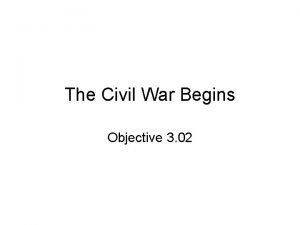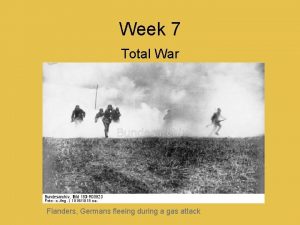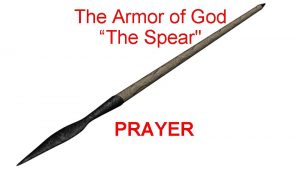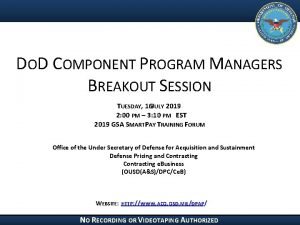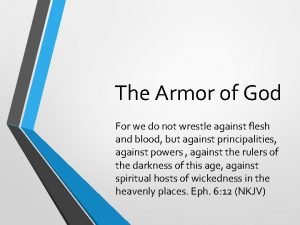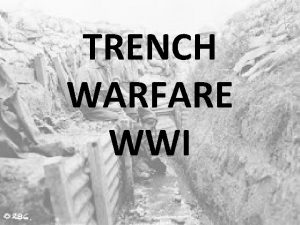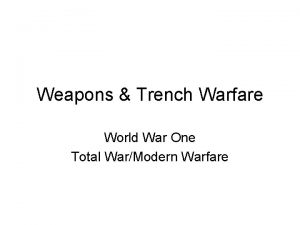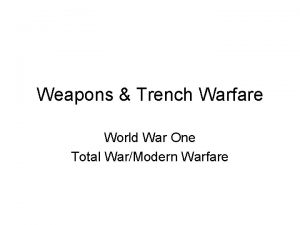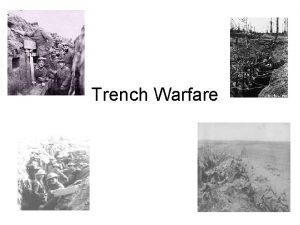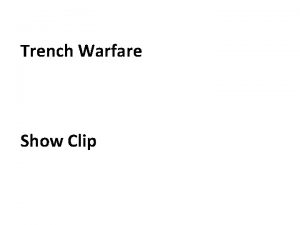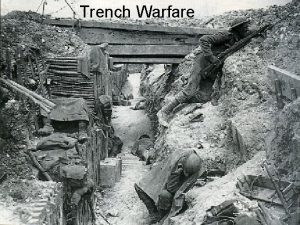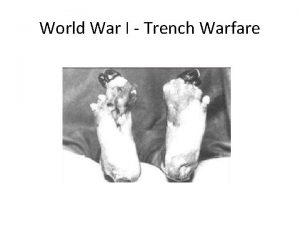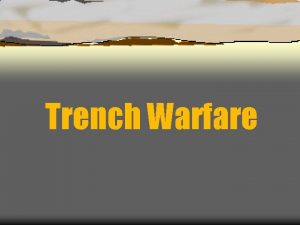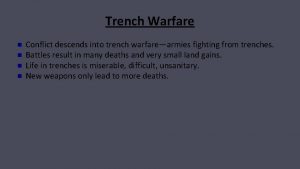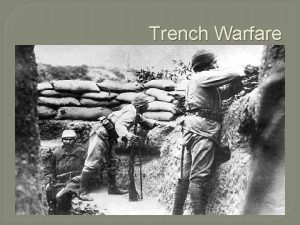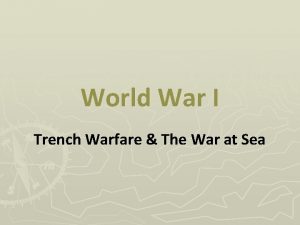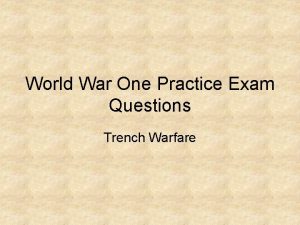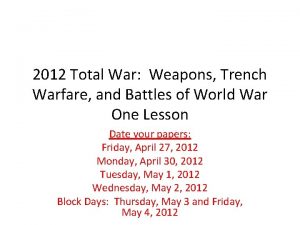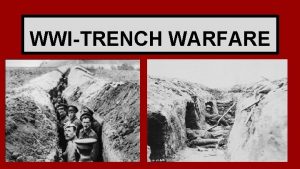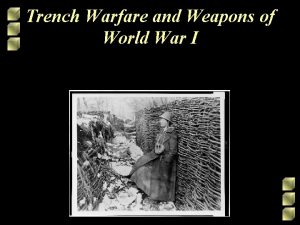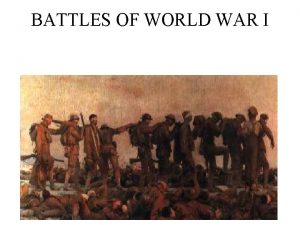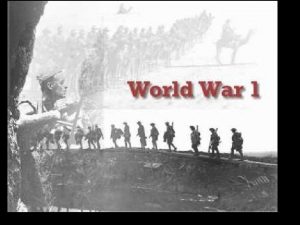Trench Warfare World War One Total WarModern Warfare































































































- Slides: 95

Trench Warfare World War One Total War/Modern Warfare

Chapter 21 • Take out Ch. 21 handout • Let’s use this as a guide for the start of today’s presentation.

A good acronym to help you remember the main causes of WWI is M. A. I. N. • • M A I N ilitarism lliances mperialism ationalism

The War to End All Wars • https: //app. discoveryeducation. com/learn/v ideos/e 3 e 2105 b-ae 68 -4460 -b 47 c 6 bb 30 a 49 b 465 • Play segment – stop at 1: 21 to analyze graph

What explains the huge jump in deaths ? WWI – 26, 000, 00 WWII – 55, 000

A modern war = more death


NEW TOYS

The Old Way of War - 1865

Modern Warfare 1914

Myth

Reality


War Is HELL !!

Real life in the trenches was MISERABLE

If you survived the fighting and didn’t get shell shock THEN there was….


This WAS a beautiful forest!

Sacrifices in War

The reality of ‘going over the top’ was very different!

Boredom, daily duties, grinding routine and more waiting. Then there were moments of sheer TERROR.


LET’S REVIEW Militarism – the new weapons of war need to be battle tested. Alliances – pull the nations into conflict. Imperialism – adds a profit motive – the land acquired enriched your country. Nationalism – Victory brings Glory to the Nation

Watch the following segment and follow along on your map. If you have a nation card – stand up when your nation is mentioned/highlighted • Imperialism and Alliances https: //app. discoveryeducation. com/learn/v ideos/126 f 646 c-edc 6 -416 c-a 8 de 172 bf 7 a 73 fab • Stop at 3: 11

DIVIDE AND CONQUER What does this mean?

Watch the following segment and follow along on your map. If you have a nation card – stand up when your nation is mentioned/highlighted • https: //app. discoveryeducation. com/learn/v ideos/4 b 6628 ed-3938 -4339 -8 bc 09859 aed 4 a 39 e

By Miss Boughey

Why were so many men lost? Trench Warfare

Trench Warfare: Reasons It Developed • Developed due to the machine gun • Traditional military charges on open land no longer worked; thousands gunned down • Needed protection from the machine gun fire, so they dug the trenches • Development of modern warfare

Trenches and Shovels • At the beginning of the war, the British army owned 2500 shovels. • By the end of the war, the British army owned over 10. 5 million shovels. • All of this was due to the development and reliance on trench warfare. • By the end of the war, both sides had dug 15, 000 miles of trenches. • That is the equivalent of digging across the United State five times.

Soldiers digging trenches while protected against gas attacks

Trenches • Were not new…used in ancient and medieval times and during the American Civil War • But trenches was not used as the main source of fighting until World War One • It was at the Battle of the Marne that the Germans were the first to dig trenches to find protection from the pursing British forces. • By the end of 1914, two lines of trenches reach across 500 miles from Switzerland to the North Sea.

Trench Warfare – type of fighting during World War I in which both sides dug trenches protected by mines and barbed wire Cross-section of a front-line trench

Anatomy of a Trench • Typically reached 10 feet deep, so soldiers could walk around without being seen by the enemy. • In areas where trenches were more shallow, a careless soldier could let his head rise above the top for enemy snipers to target. • Trenches had duckboards, or wooden planks at the bottom, which kept feet dry and out of the mud.


Anatomy of a Trench • Trenches contained saps, short cul-desacs dug forward and connected to the front line trench by a little tunnel. • Each night, two guards crawled out to the sap and sat for hours. • They listened for sounds from the enemy’s line or any movement or noise that could signal attack preparations.


Trench Warfare in France

BARBED WIRE • Trenches on the Western Front were protected by thick barbed-wire entanglements. • Being a member of a wiring party was one of the most unpopular duties experienced by soldiers. • This involved carrying out 6 ft. steel pickets and rolls of wire. • The pickets were knocked into place by muffled mallets. • When fastened to the pickets, the wire was pulled out to make what was known as an apron. Barbed-wire was usually placed far enough from the trenches to prevent the enemy from approaching close enough to lob grenades in. • Sometimes barbed-wire entanglements were set up in order to channel attacking infantry into machine-gun fire. Barbed-wire entanglements were virtually impassable. • Before a major offensive soldiers were sent out to cut a path wire-cutters. • Another tactic was to place a Bangalore Torpedo (a long pipe filled with explosive) and detonate it under the wire.



An aerial photograph of the opposing trenches and no-man's land in Artois, France, July 22, 1917. German trenches are at the right and bottom, British trenches are at the top left. The vertical line to the left of centre indicates the course of a pre-war road.

View from the air TODAY of trenches dug during WWI

Fighting Trench Warfare • Goal was to take the opponent’s trench— very hard to do; often ended in stalemate and high casualties • Would go over the top and charge across no-man’s land under the cover of rolling artillery barrages, poison gas, behind tanks, facing machine gun fire • Almost all the new weapons that developed were to help break the trenches

Western Front – over 400 miles of trenches across Belgium and France · Most offenses resulted in heavy casualties but gained little territory.

The Trench Cycle • • • 70 days in the front line 30 days in a nearby support trench 120 days in a reserve trench 70 days spent at rest The amount of leave varied with up to 2 weeks a year.


What should be the caption for this photo?


French soldiers firing over their own dead

Trench Warfare: Conditions • • • Lice Rats Cramped up Flooded trenches Diseases Decaying flesh

Life in the Trenches • James Lovegrave described life in the trenches as “Life in the trenches was hell on earth. Lice, rats, trench foot, trench mouth, where gums rot and you lose your teeth. And of course dead bodies everywhere. ”

No smiling and relaxed faces… No clean uniforms… Their equipment is scattered everywhere… Boredom and sleep are obvious…

Soldiers were expected to carry all of their equipment with them at all times. They were supposed to keep it clean and in good condition.


How the uniform and equipment changed after just three weeks in the trenches…

Going Over the Top • Phrase given to the soldiers when it was time to try to take the opposing trench • Means running across no-man’s land • About 8 out of every 10 soldiers who went over the top would die


We started away just after dawn from our camp and I think it was about an hour later that we encountered the enemy. They were on the opposite side of the valley and as we came over the brow of the hill they opened on us with rifle fire and shrapnel from about 900 yards. We lost three officers and about 100 men killed and wounded in that half hour. I do not want any more days like that one. (this section censored) Anyway we drove the Germans back and held them there for eight days. I cannot tell you all I should like to, as it would never reach you. Private James Mitchell in a letter to his father on October 17 th, 1914.

Over the Top



Few soldiers ever made it to the other side’s trenches.

No Man’s Land

Trench Warfare “No Man’s Land”

No-Man’s Land • Term used by the soldiers to describe the ground between the 2 opposing trenches • Width could vary from 500 yards to as narrow as 7 yards; the average was 250 yards • Contained a lot of barbed wire; some places 100 ft deep • If there had been a lot of fighting, no-man’s land was covered with abandoned military equipment, the rotting corpses, and total annihilation of the land with shell holes • At the Battle of Somme, 200, 000 men were left to rot in No-Mans Land

At times electrified cable ran thru the mass of barbed wire-had to be cut first!! Barbed wire strung out over No Man’s Land slowed speed of the advance of the attacking troops

No Man’s Land


No Man’s Land

No Man’s Land

PROBLEM: When it rained the trenches flooded, resulting in a horrible medical condition called “trench foot”. Because of the moisture, the soldiers feet literally rot.

Heath Issues: Trench Foot • An infection of the feet due to cold, wet, & unsanitary conditions • Men stood for hours in waterlogged trenches without being able to remove wet socks or boots • The feet would go numb, the skin turn red or blue • If untreated, the trench foot would turn gangrenous and have to be amputated • Between 1914 -1915, over 20, 000 British soldiers were treated for trench foot • Only remedy was to dry feet & change socks several times a day • Men also covered feet with grease from whale oil to make them water-resistant

• Trench Foot

Trench Foot • “If you have never had trench feet described to you, I will tell you. Your feet swell to 2 to 3 times their normal size and go completely dead. You could stick a bayonet into them and not feel a thing. If you are fortunate enough not to lose your feet and the swelling begins to go down. It is then that the intolerable, indescribable agony begins. I have heard men cry and even scream with pain and many had to have their feet and legs amputated. ”

Debilitating Injuries

Trench Mouth • Soldiers who had not brushed their teeth for days would suffer from trench mouth. • The symptoms were bleeding gums, ulcers of the mouth and very bad breath


• In the summer months flies, attracted by unburied bodies and human waste, swarmed over wounds, into mouths and food. • Lice and flea infestations, spread by rats and close contact, tormented soldiers with itchy bites. • They also could make bits of discarded uniform move across the trench!

Flies • On soldier of the Australia and New Zealand Army Corps (Anzacs) wrote home about the flies: • “Some of them must have tin openers on their feet, they bite so hard. ” • Another British soldier complained: • “In order to eat your food you have to wave your hand over it and then bite suddenly, otherwise a fly came with it. Any bit of food uncovered was blotted out of sight by flies in a couple of seconds. ”

Lice

Health Issues: Lice • The average British soldier had 20 lice crawling over his body. • The record was 10, 428. • Blotchy red bite marks all over the body that created a sour stale smell • Used a lighted candle to burn the lice off the skins • When they could, the men would bathe in huge vats of hot water while their clothes were deloused; but this did not work • Within 2 to 3 hours, the remaining eggs in the clothes would hatch due to the body heat • Frenzied scratching of the lice bites led to Trench Fever (pyrrexhia) that resulted in shooting pains in the shins and a very high fever • 15% of all cases of sickness was due to lice issues

• Lice are about the size of a sesame seed, about as long as a hyphen -. • They have six legs with claws that they use to pull themselves along hair and clothing. • They do not fly or jump. • They take on the color of the surrounding background much like a chameleon, so they may be black, yellow, brown, whitish, or reddish.

delousing

The soldiers had very little decent food, and what food they had was often attacked by rats. These rats were the size of small rabbits and badgers because they had fed on the decomposing bodies of dead soldiers.

Towards morning, while it is still dark, there is some excitement. Through the entrance rushes in a swarm of fleeing rats that try to storm the walls. Torches light up the confusion. Everyone yells and curses and slaughters. The madness and despair of many hours unloads itself in this outburst. Faces are distorted, arms strike out, the beasts scream; we stop just in time to avoid attacking one another. ” Erich Remarque, All Quiet on the Western Front Source: http: //

Rats killed in one trench

Rats • Rats became a problem in trenches during World War 1. • They were attracted by the despicable smell and damp conditions. • Rats would eat men's uniforms & generally just run around in the trenches. • Sometimes they would bite soldiers, in desperation of hunger, which would cause extreme pain & often lead to infection. • In extreme cases, a wounded or unprotected soldier could be eaten alive by a large group of rats. • Dead corpses would often be eaten by the rats. • One soldier described the rats as `small dogs' that would attack and eat anything. • Wounded men were often afraid to go to sleep in their beds and men tried to secure their food during the night to stop rats from getting it.

Rats • Rats in their millions infested the trenches. • Two main types: brown & black rats • Brown Rats most feared for they gorged themselves on the human remains & grew to the size of cats. • The men would hunt them with gunfire, bayonet, or clubbing them to death. • Rats spread infections & contaminated the food.


Rats


German Soldiers and Trench Cats • German soldiers kept cats in the trenches to catch rats. • The cats also gave early warnings of a British gas attack. • They became restless, as though they could scent the poison gas before the main cloud appeared.

Trench Warfare: Analysis • This was their new tactic in war. • After the war, it had left horrific scars. • Made many people not want to have another World War ever again.

The Cost of War
 Trench warfare propaganda
Trench warfare propaganda The war to end all wars
The war to end all wars Why did trench warfare happen
Why did trench warfare happen How did the treaty of versailles affect postwar germany?
How did the treaty of versailles affect postwar germany? Why were military leaders baffled by trench warfare?
Why were military leaders baffled by trench warfare? Total war world history definition
Total war world history definition Cold war jeopardy review game
Cold war jeopardy review game One world factors
One world factors World war one
World war one World war one
World war one World war one
World war one World war one
World war one “we are trying to prevent a world war, not start one”
“we are trying to prevent a world war, not start one” Alliances cartoon
Alliances cartoon Long term causes of world war one
Long term causes of world war one Sin entered through one man
Sin entered through one man Formula de roe
Formula de roe Total revenues minus total costs equals
Total revenues minus total costs equals Total revenues minus total costs equals
Total revenues minus total costs equals Total revenues minus total costs equals
Total revenues minus total costs equals Total revenue minus total expenses
Total revenue minus total expenses One god one empire one emperor
One god one empire one emperor One one one little puppy run
One one one little puppy run One king one law one faith
One king one law one faith Byzantine definition
Byzantine definition Ford one plan
Ford one plan See one do one teach one
See one do one teach one One price policy
One price policy Night structure
Night structure See one do one teach one
See one do one teach one One vision one identity one community
One vision one identity one community Asean one vision one identity one community
Asean one vision one identity one community Ring of fire
Ring of fire What are four types of plate boundaries?
What are four types of plate boundaries? Whats a sap trench
Whats a sap trench What is a sap trench
What is a sap trench Where did the battle of jutland occur
Where did the battle of jutland occur Mara sanz
Mara sanz Aco trench drains
Aco trench drains Bangalore hot fermentation method is a
Bangalore hot fermentation method is a Trench breadboard
Trench breadboard Arti cable tray
Arti cable tray Shallow trench isolation
Shallow trench isolation Underground heat exchanger
Underground heat exchanger Ocean basin profile
Ocean basin profile Parados trench
Parados trench Shallow trench isolation
Shallow trench isolation Cut off trench
Cut off trench Difference between frostbite and trench foot
Difference between frostbite and trench foot Bab2
Bab2 Examples of propagation
Examples of propagation Trench foot images
Trench foot images Swollen corpse in a waterlogged trench
Swollen corpse in a waterlogged trench Trench foot images
Trench foot images Trench layering
Trench layering Mount fuji tectonic plate
Mount fuji tectonic plate A narrow trench in the highest part of the mid ocean ridge
A narrow trench in the highest part of the mid ocean ridge 1926 excavation
1926 excavation Nwell
Nwell Trench letter
Trench letter South sandwhich trench
South sandwhich trench Firebay trench
Firebay trench A narrow trench in the highest part of the mid ocean ridge
A narrow trench in the highest part of the mid ocean ridge Excavation and backfill calculation
Excavation and backfill calculation Population density map australia
Population density map australia Disadvantages of rubble trench foundation
Disadvantages of rubble trench foundation Trench foot
Trench foot What is a trench
What is a trench Puerto rican trench
Puerto rican trench Maraian trench
Maraian trench Trench cost
Trench cost Mariana trench
Mariana trench What was the union's three part plan
What was the union's three part plan Who is the target audience
Who is the target audience Total war
Total war Joint warfare analysis center
Joint warfare analysis center Computer set an/uyk-128(v)3
Computer set an/uyk-128(v)3 Ptsd spiritual warfare
Ptsd spiritual warfare Biological warfare pros and cons
Biological warfare pros and cons Unrestricted submarine warfare
Unrestricted submarine warfare Ephesians weapons of warfare
Ephesians weapons of warfare Spear in spiritual warfare
Spear in spiritual warfare Ferris
Ferris Mania world war i
Mania world war i Undersea warfare conference
Undersea warfare conference Ancient warfare weapons
Ancient warfare weapons Olmec warfare
Olmec warfare Our warfare is not against flesh and blood
Our warfare is not against flesh and blood Define spiritual warfare
Define spiritual warfare Guerilla warfare
Guerilla warfare Nswc pd
Nswc pd Mayan warfare
Mayan warfare Naval surface warfare center
Naval surface warfare center Guerilla warfare
Guerilla warfare The three battlegrounds
The three battlegrounds Armor of god prayer
Armor of god prayer


